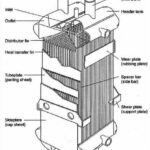How to calculate the heat duty for heat exchangers?
Lets first define the term “Heat duty” to understand what understand what exactly we are calculating. The Heat duty can be defined as the amount of heat needed to transfer from a hot side to the cold side over a unit of time.
The calculation is very important to all engineers and it’s one of the common ones that you need to know in your career if you are a process engineer. The equation to calculate the heat duty is normally written in two ways.
One that can be used for sensible heat transferred, this means that the fluid undergoes no phase change.
The other can be used for latent heat transferred, this means that the fluid undergoes a phase change. i.e. condenses.
Heat Duty (Sensible heat – No phase change)
Q = M * Cp * ∆T
Where;
Q – is the heat duty or the total heat transferred. Btu/hr or W
M – is the Mass flow rate for the fluid undergoing the temperature change. lb/hr or kg/s
Cp – is the heat capacity of the fluid undergoing the temperature change. Btu/lb.°F or J/kg.°K
∆T – is the temperature change in fluid normally calculated as the difference between outlet and inlet temperatures. °F or °C
I have put two different measurement units for each of the variables above, the first being in English / US Units and the second is in SI Units. There is many other variations but the above are common and I use all the time. The most important thing is to make sure your units of measurement is correct and consistent with the calculations.
Heat Duty (Latent heat – Phase change)
Q = M * λ
Where;
Q – is the heat duty or the total heat transferred. Btu/hr or kW
M – is the Mass flow rate for the fluid undergoing the temperature change. lb/hr or kg/s
λ – is the latent heat. Btu/lb or kJ/kg
For the hot side this is the Latent heat of Condensation of the vapor that is changing phase.
For the cold side this is the Latent heat of Vaporization of the liquid that is changing phase.
The equation can also be written in terms of the enthalpy change by replacing the λ with (H2 – H1) referring to the change in enthalpies of the fluid undergoing temperature change and this is also expressed in Btu/lb or kJ/kg
Heat Duty for Multiphase streams
If you have a stream where more than one phase exists then you can calculate the heat duty using the equation below:
Q = Qg + Qo + Qw
Where;
Q – is the overall heat duty or total heat transferred, Btu/hr or kW
Qg – is the gas heat duty or heat transfer rate, Btu/hr or kW
Qo – is the oil heat duty or heat transfer rate, Btu/hr or kW
Qw – is the water heat duty or heat transfer rate, Btu/hr or kW
Links
Here is a free heat duty calculator that I built – you can read more about it from the webbusterz engineering software using the link below:
Desktop software – Heat duty calculator – sensible and latent heat
Android application – click here to visit our google play apps
What is subcooling and how to calculate the heat duty when subcooling is involved? read this article
What is superheating and how to calculate the heat duty when superheating is involved? read this article










